The photo for today’s post is one of my father’s, taken in 1948 in Lower Thames Street, looking up towards the tower of the church of St Dunstan in the East:

Today, the same view is totally obscured by the office buildings that now line the northern side of Lower Thames Street. The following photo is the closest I could get to reproducing the view, and was taken a short distance down Cross Lane:

Cross Lane turns into Harp Lane and continues down to Lower Thames Street, and it was around here from where my father took the original photo. Lower Thames Street can be seen on the left and the office blocks that obscure the view on the right:
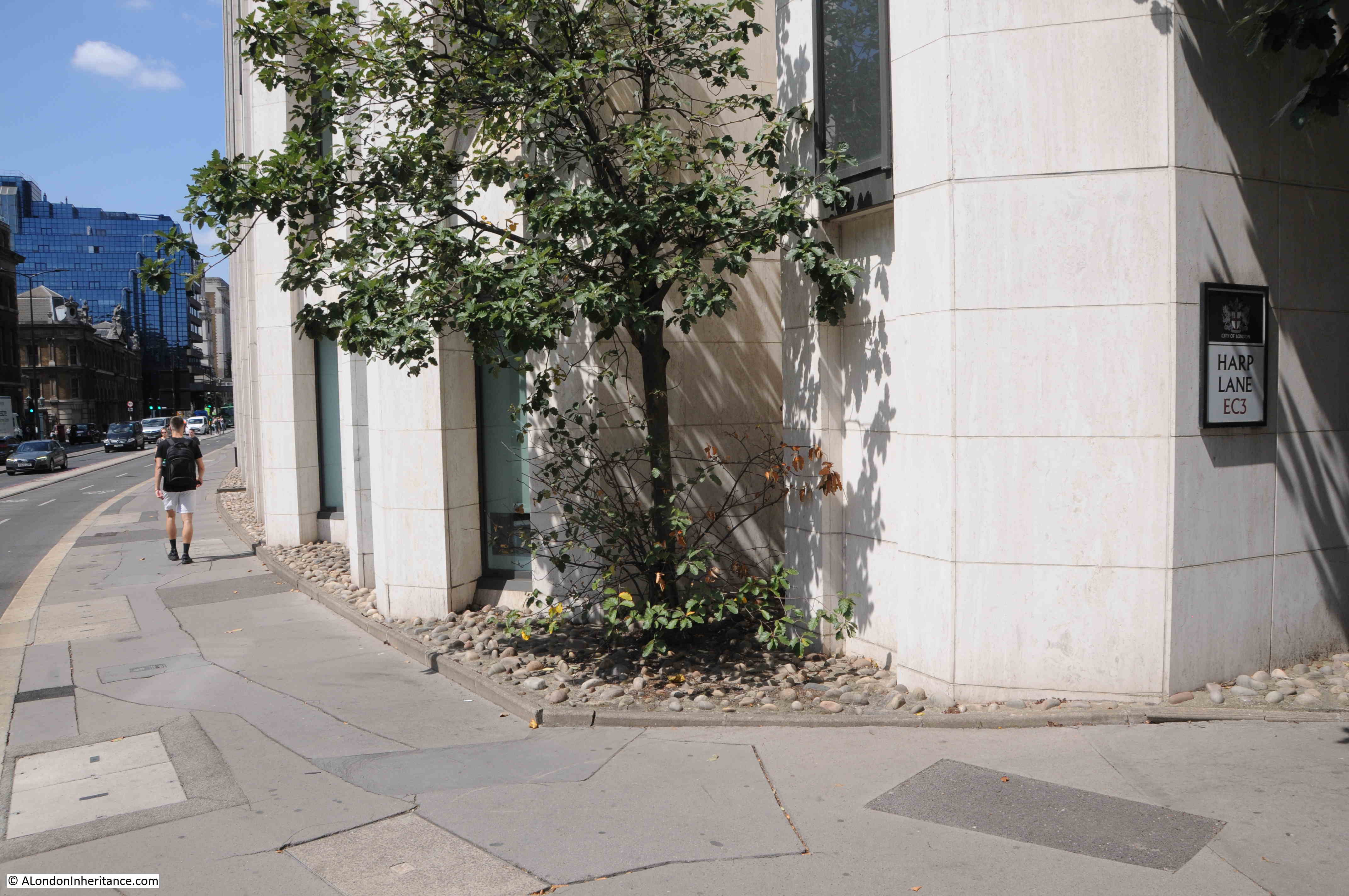
The very distinctive tower of St Dunstan in the East dates from the Christopher Wren rebuild of the church after the Great Fire. The walls of the church had been rebuilt using Portland stone before the fire so did survive, however the church needed a new tower.
The church has long possessed a distinctive tower and spire. In the following extract from the Civitas Londini map of around 1600, the spire of St Dunstan in the East is one of the few labelled, and can be seen rising much higher than surrounding churches (© The Trustees of the British Museum):
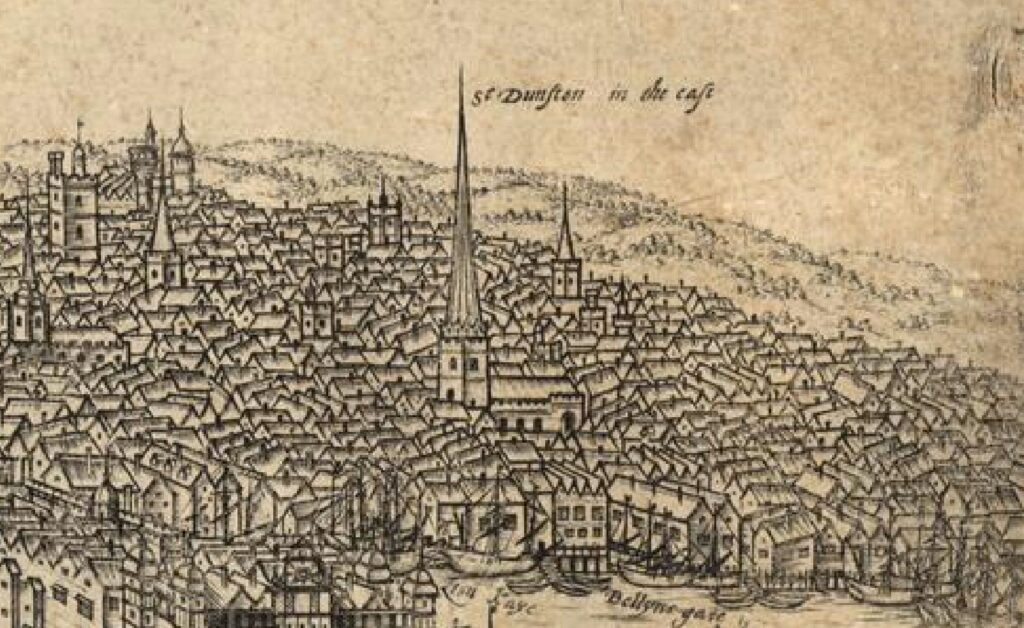
The book “London Churches Before the Great Fire” (Wilberforce Jenkinson, 1917) provides some background:
“The church was built not later than the thirteenth century; possibly earlier. The first rector, so far as any records go, was John de Pretelwelle, who vacated in 1310, The church is one of those termed ‘Peculiar’. It was destroyed in the Great Fire, and rebuilt by Wren, with a spire somewhat notable but not so lofty as that of the old church, which in Visscher’s map appears to be the loftiest in the City, St Paul’s only excepted.”
The term ‘Peculiar’ was given to churches that were exempt from the jurisdiction of the Bishop of London and were under the Archbishop of Canterbury. There were thirteen City of London churches in this category: All Hallows, Bread Street; All Hallows’ Lombard Street; St Dionys, Backchurch; St Dunstan in the East; St John Evangelist; St Leonard Eastcheap; St Mary, Aldermanbury; St Mary-le-Bow; St Mary Bothaw; St Mary, Crooked Lane; St Michael Royal; St Pancras, Soper Lane; St Vedast.
Saint Dunstan was a Saxon Archbishop of Canterbury, so it may be this dedication that brings the church under the Archbishop of Canterbury rather than the Bishop of London.
Wilberforce Jenkinson’s book tells the story of a 17th century rector of the church, and the penalty at the time for blasphemy:
“Dr Childerley, rector of this church, exhibited his prowess as an athlete in rather an eccentric manner. it seems that one Hackett, an imposter who claimed to be a sort of Messias, and who boasted that he was invulnerable and that anyone might kill him if he could, was arrested and imprisoned in Bridewell.
Dr Childerley repaired unto him and proffered to gripe hands with him and try the wrists, which Hackett unwillingly submitted to do. The Doctor fairly twisted his wrists almost to the breaking thereof, but not to the bowing of him to any confession or remorse.
Hackett was subsequently hanged at the cross in Cheapside, blaspheming to the last breath.”
The view looking up towards the church from St Dunstan’s Hill:
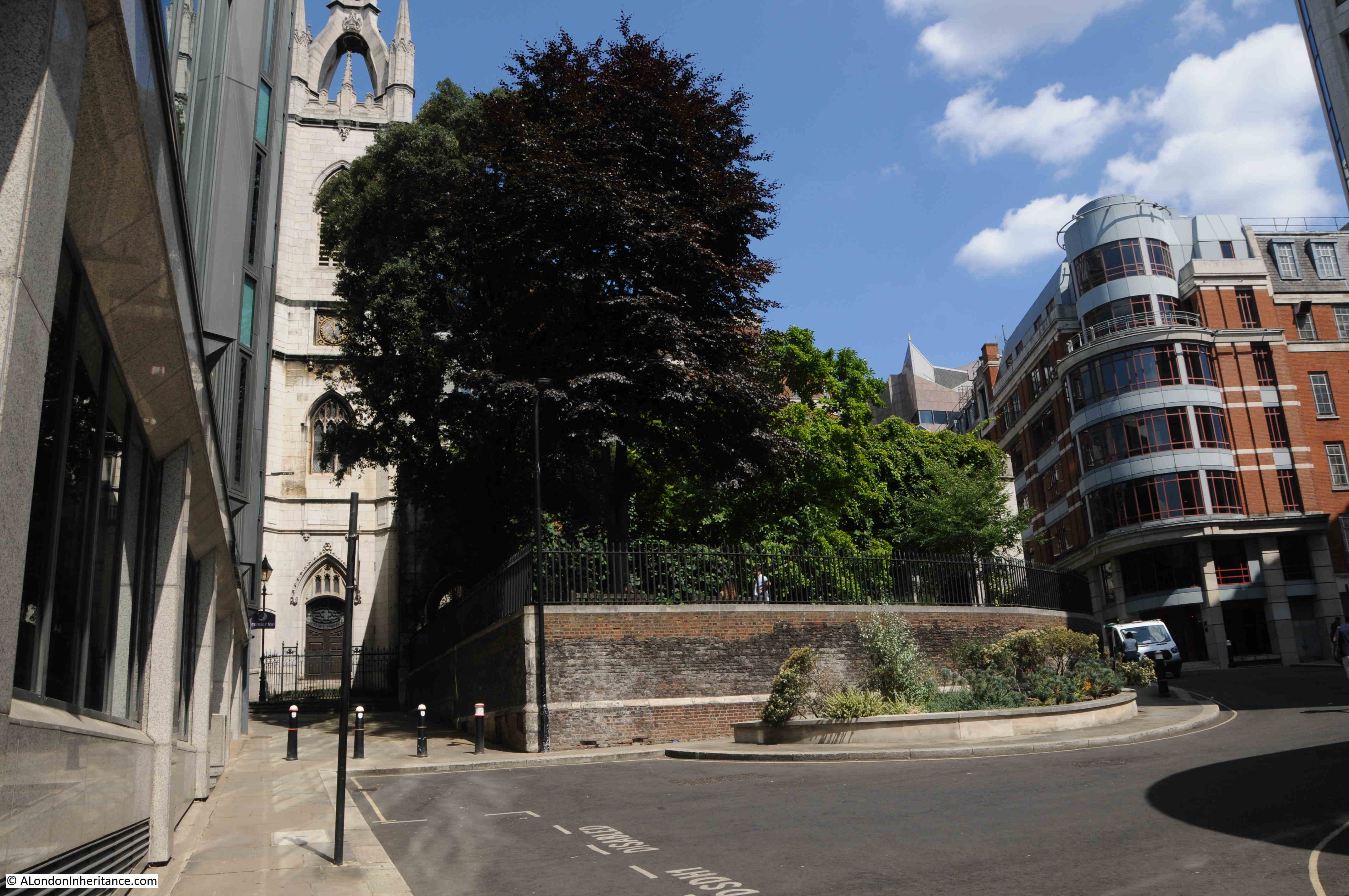
In my father’s photo, a clock can just be seen half way up the tower. The following closer view of the tower shows the clock today:
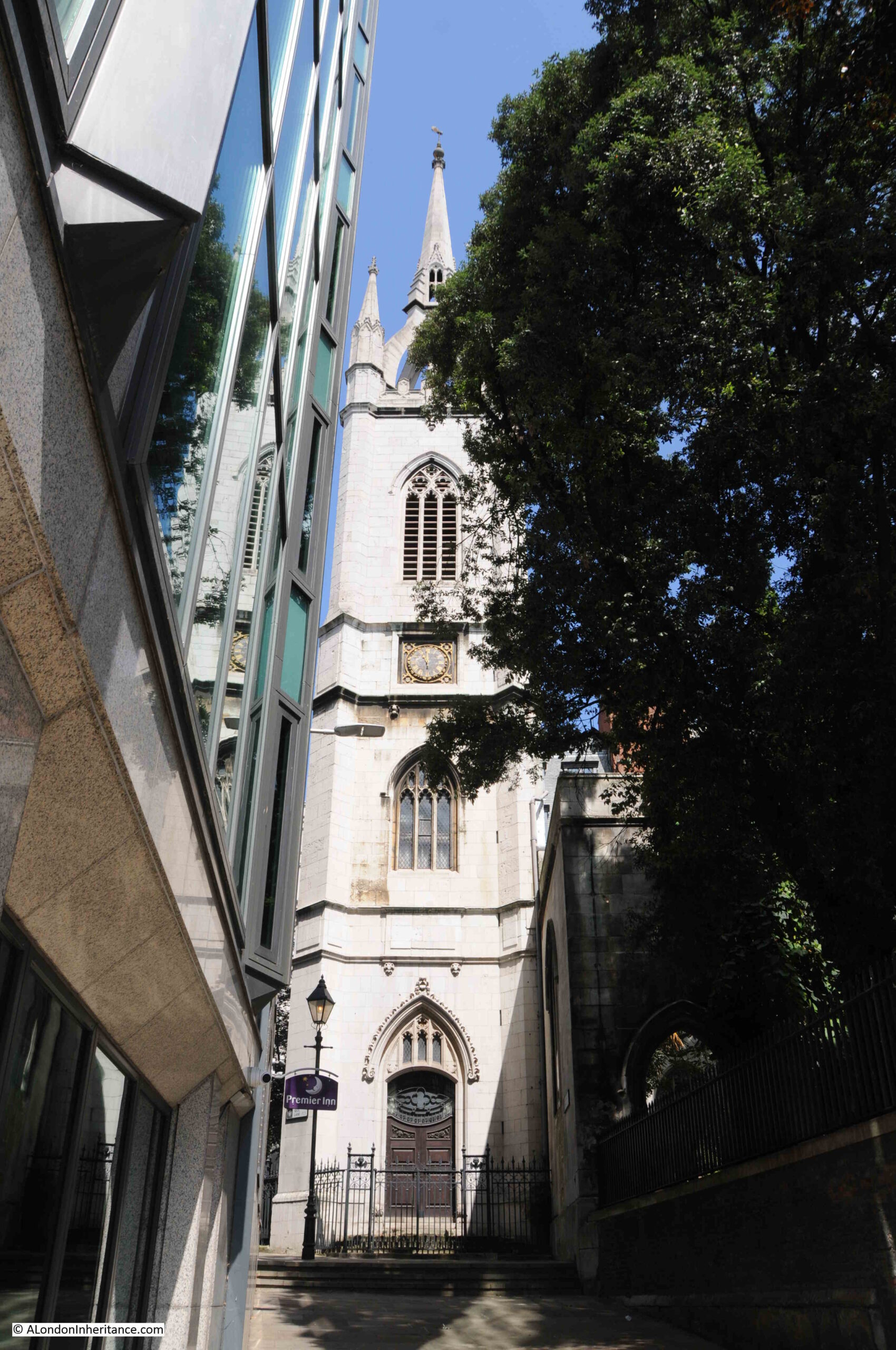
A closer view of the clock, which has the year of 1953 in numbers at the four corners of the clock:
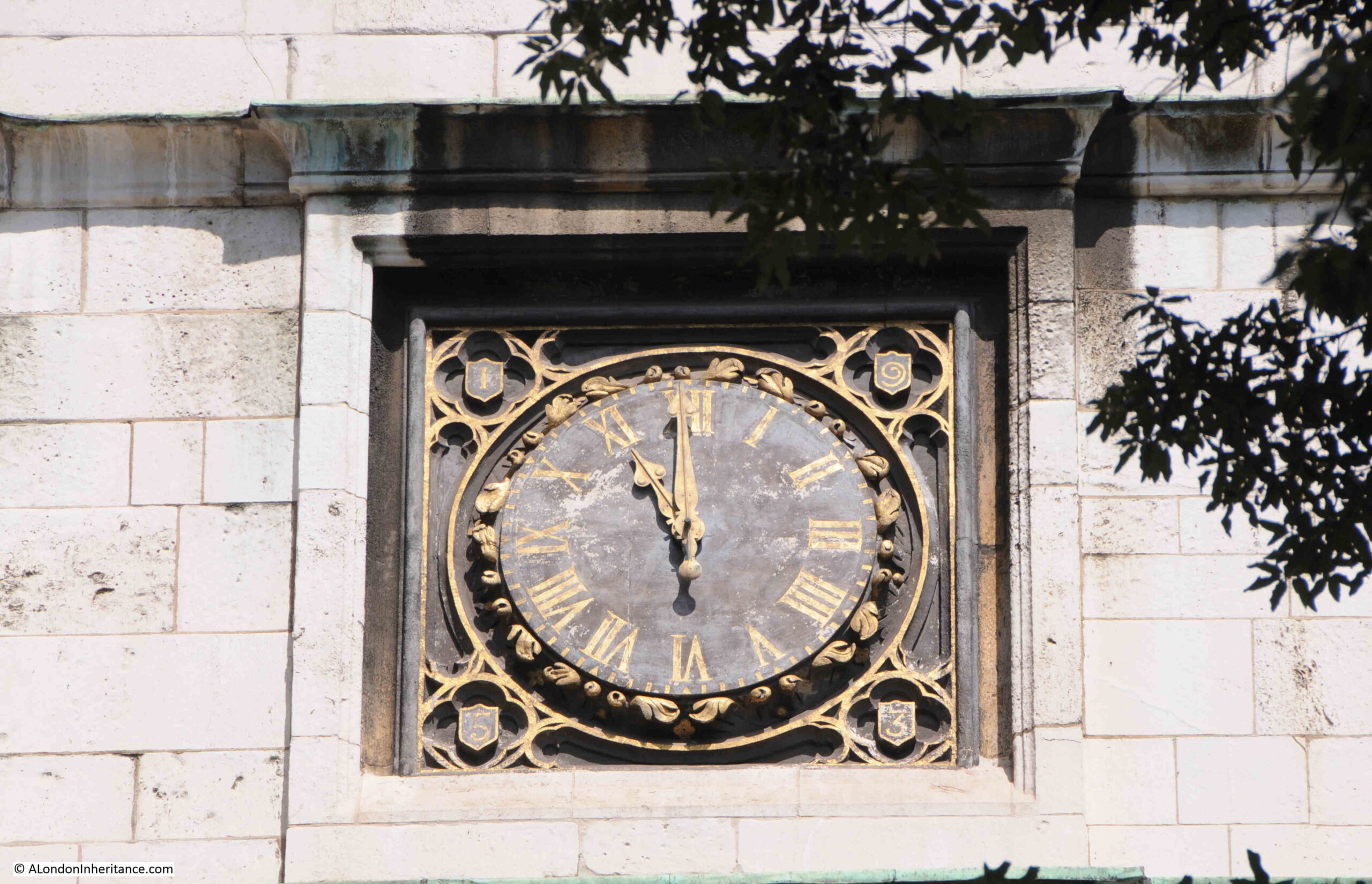
1953 is the year when restoration of the tower was finished. The tower does not look in too bad a condition in my father’s 1948 photo, however it did need some significant work to make it safe.
Newspaper reports from June 1950 covered the start of restoration work:
“A start has been made on the restoration of another of the City’s bomb-shattered churches, that of St Dunstan in the East. As one of Wren’s masterpieces, this church is fortunate because it has been scheduled as a national monument (it was Grade I listed in 1950) and all the difficulties of obtaining a building licence have been swept away. For some time scaffolding has surrounded the steeple, the dismantling of which is expected to take about six months.
Each stone is being numbered in order that it can readily be fitted into its old place when rebuilding begins. Meanwhile the bells which fell when the church was bombed in 1941, have been brought out from the vestry where they had been stored, and in about a year’s time will ring out again. There has been a church on this site for a thousand years.”
As usual with any City church, this was not the first restoration. I have already mentioned the Wren rebuild after the Great Fire, however in 1817 the body of the church needed a rebuild, as the walls which had survived the Great Fire, had been pushed out of the vertical by 7 inches due to the pressure of the roof.
The Public Ledger and Daily Advertiser on the 27th November 1817 reported on the start of the restoration;
“His Grace the Archbishop of Canterbury laid the first stone yesterday, with a bottle containing the coins of the realm, and a brass plate, with an inscription commemorative of the event, for the restoration of the Parish Church of St Dunstan East, assisted by the Rev. Rob Hesketh, Rector; John Howe and William Ruston, Wardens, and the Gentlemen of the Church and Rebuilding Committees. Mr. Laing is the architect, who produced a south view of the intended building, which is to be of Portland stone, entirely Gothic, and made to correspond as nearly as possible with the universally admired structure of the Steeple, built by Sir Christopher Wren.”
The main entrance to the church is in Idol Lane, where in the following photo the base of the tower and entrance can be seen on the right:
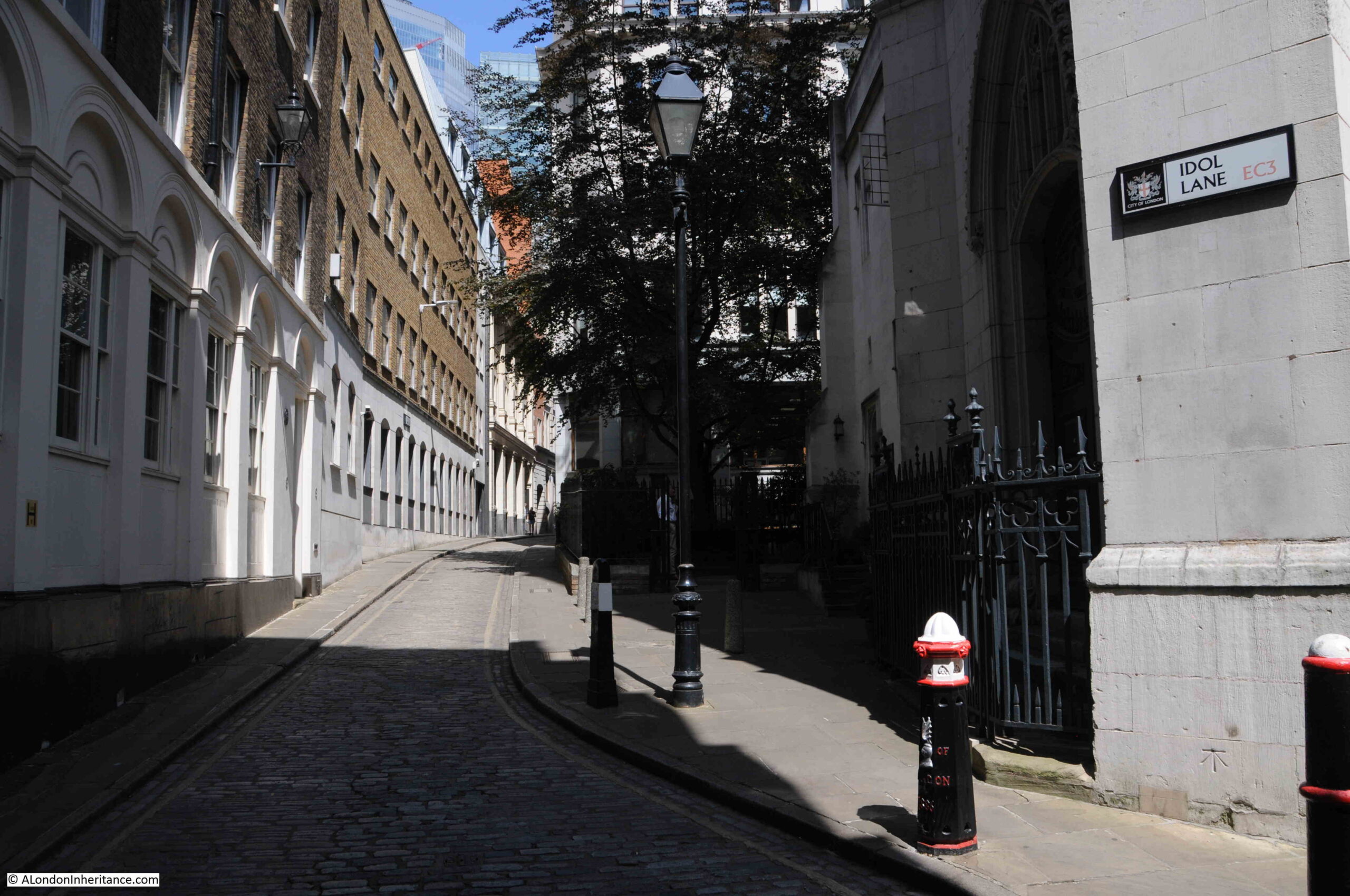
Idol Lane has an interesting history. The earliest mention dates from 1666 when it was called Idle Lane. A reference to the street in 1708 refers to the street being called Idol Lane as in old records there were “makers of idols or images living there”, however there is no evidence to support this.
The following extract from a 1754 map of Tower Street Ward shows St Dunstan’s, with Idle Lane to the west. The map also provides an impression of the scale and view of the church before the 19th century rebuild (© The Trustees of the British Museum).

From Idol Lane we can walk into the ruins of the church.
Whilst the tower was restored in the early 1950s, the walls were left as they were following the damage caused by bombing, so we can walk around the shell of the old church.
The shell of the church and immediate surroundings were turned into gardens in 1971, and they now form one of the many remarkable sights in the City. The following photo is a view alongside the north wall of the church, with one of the old pinnacles that once stood on top of the church:

The south side of the church has a small fountain in the centre of the gardens which in the summer are a haven for City workers:
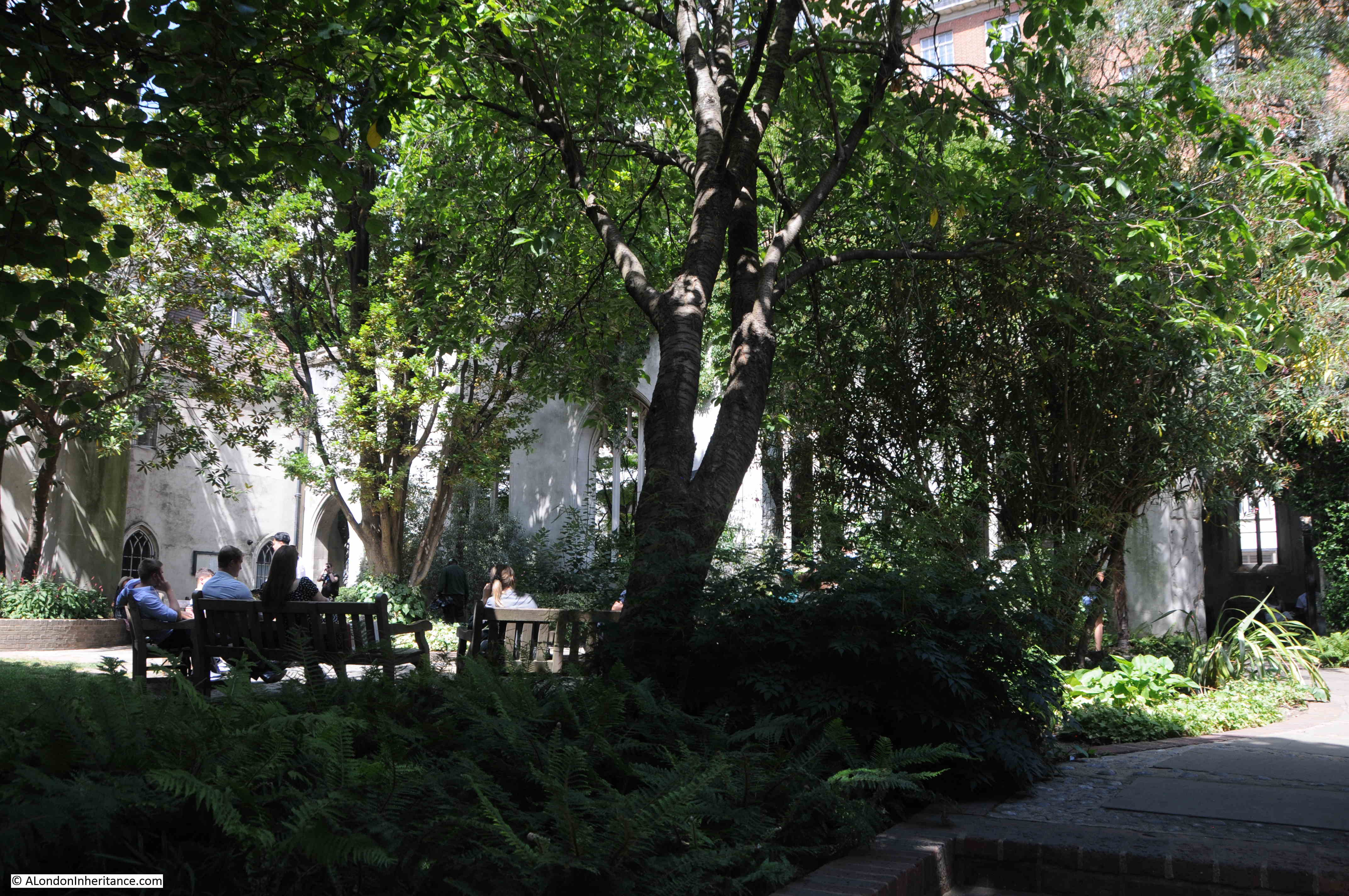
Doorway into the east entrance to the church:

View along the southern wall of St Dunstan in the East:
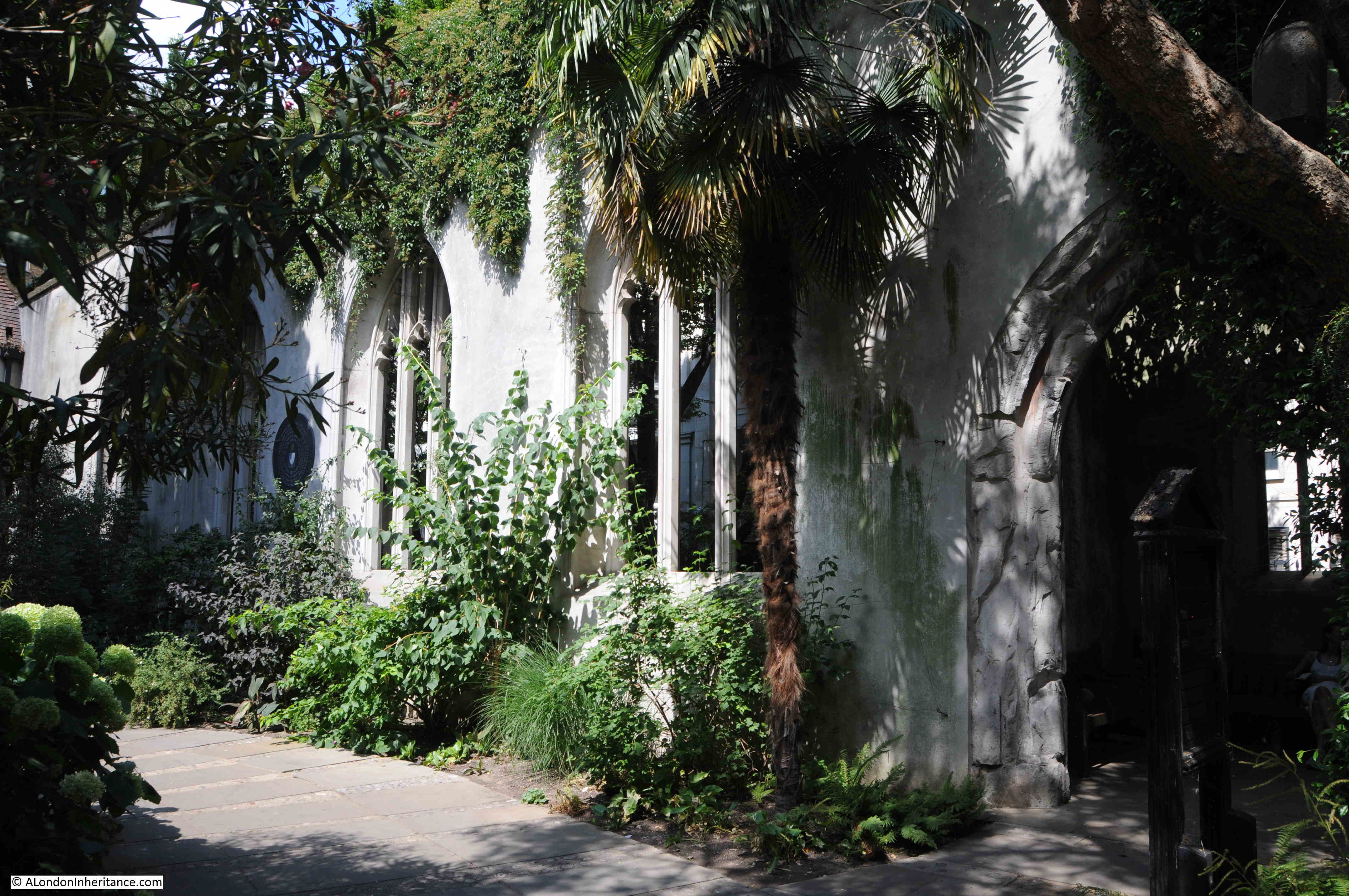
The 1817 rebuild by Mr. Laing, resulted in a design that at the time was quoted as being “entirely Gothic“. I doubt that Mr. Laing could have realised quite how gothic the church would appear, 200 years later:

The interior of the church:
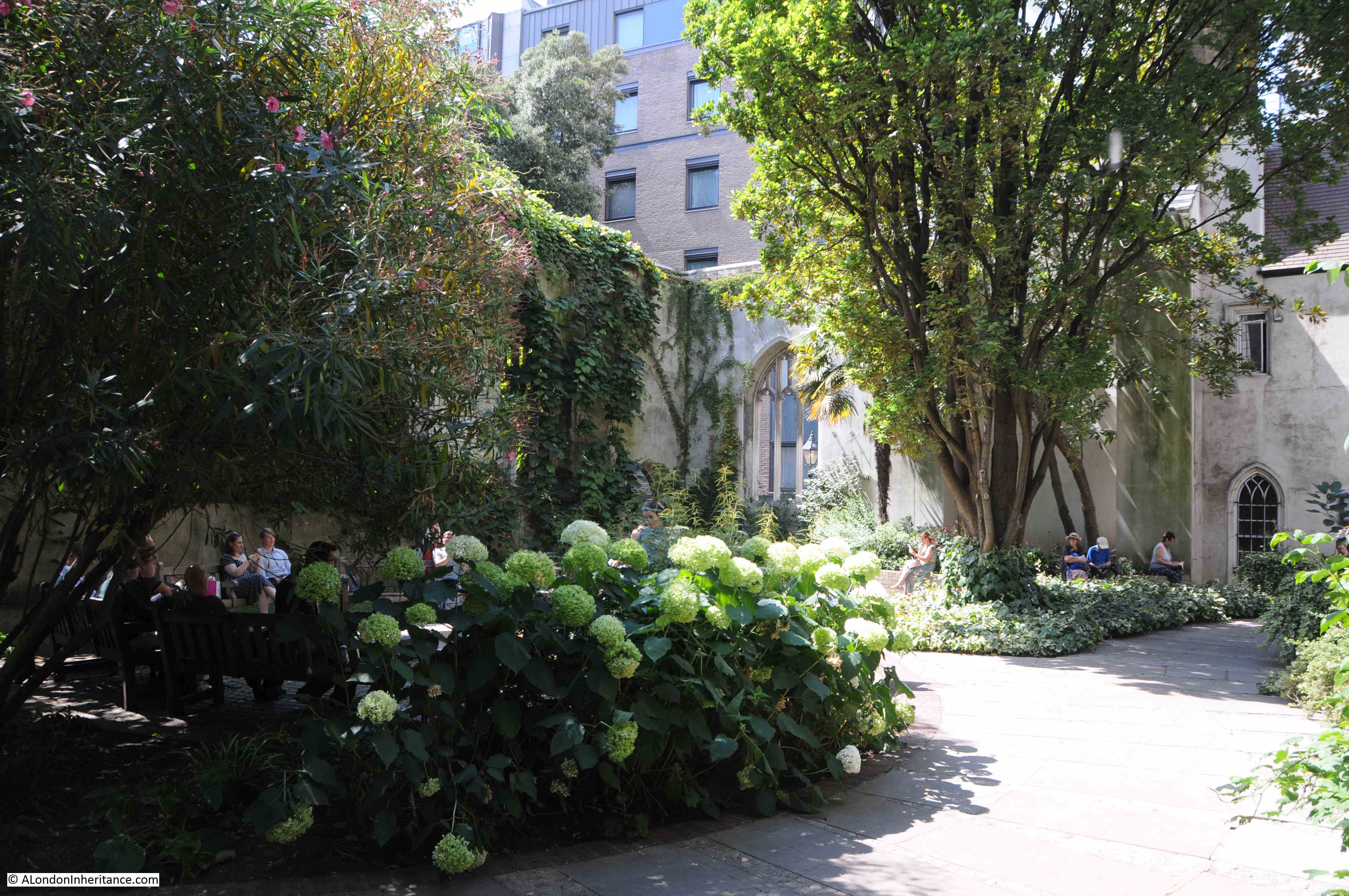
From St Dunstan’s Hill, we can see the eastern entrance to the church, and the top of the tower. Wren’s design is wonderful. Pinnacles are placed at each corner of the tower, and behind the pinnacles, a flying buttress supports the central lantern and spire:
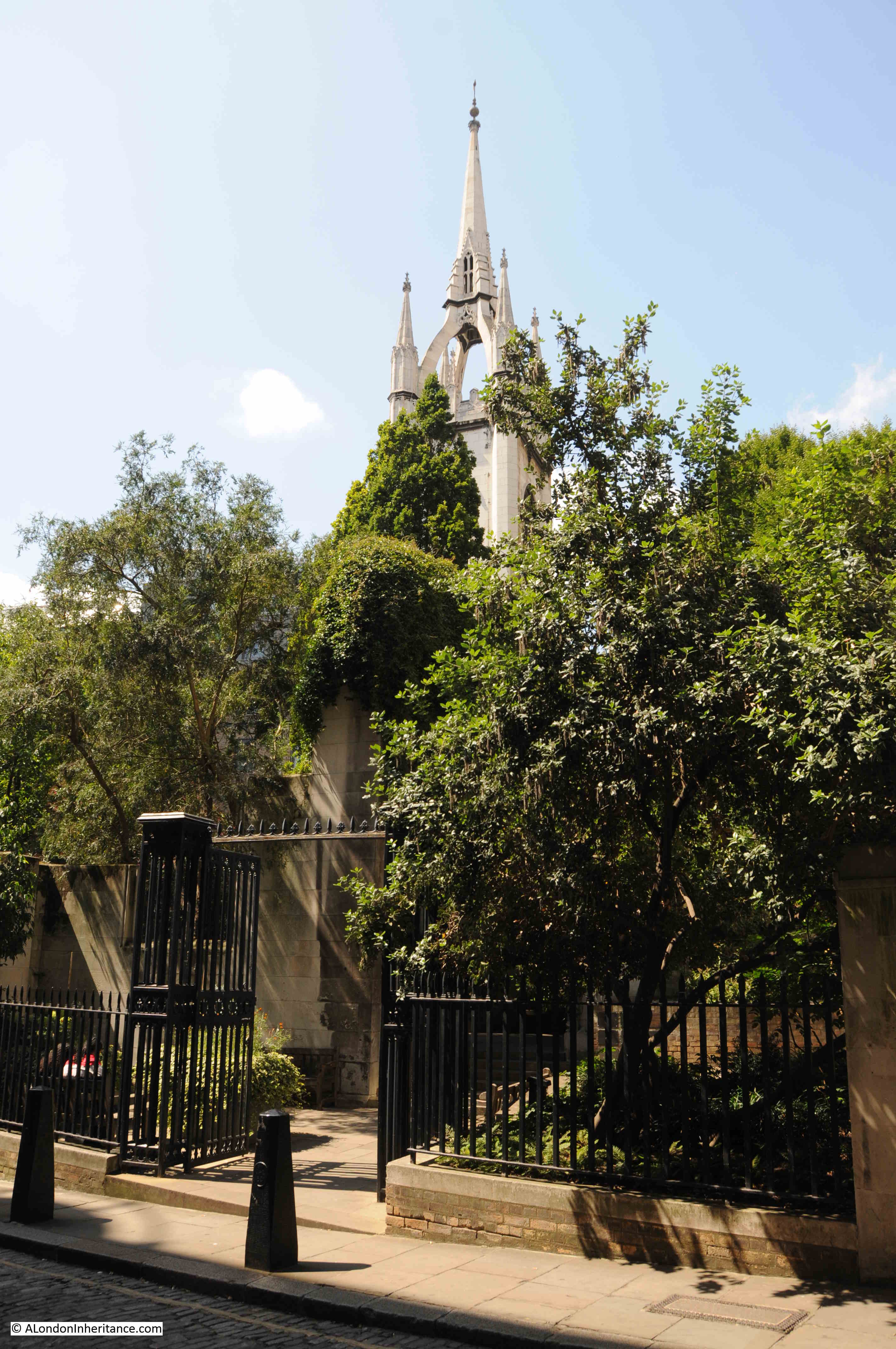
St Dunstan in the East is a short distance from the old Billingsgate Market, and workers at the market use to donate fish, geese etc. to the harvest festival at the church.
Looking back to my father’s photo, and to the right of the photo, facing onto Lower Thames Street is what I suspect was a café. The board in the window states that it is open from 5.45 am to 4 pm. I suspect the early start was to provide breakfast to the workers at the market. The photo is just one of many where I wish my father had enough film, turned to the right and took another photo.

The left of the photo shows the level of bomb damage along Lower Thames Street.
The preservation of St Dunstan in the East is rather wonderful. The tower and spire show one of Wren’s best designs across the post fire City churches, and the gardens surrounding the walls of the church are a brilliant place to sit on a summer’s day.
The church is also good to walk past on a quiet, winter’s moonlit night, when Laing’s Gothic design really comes alive.
